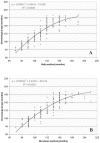Dental maturity as an indicator of chronological age: radiographic assessment of dental age in a Brazilian population
- PMID: 19089110
- PMCID: PMC4327238
- DOI: 10.1590/s1678-77572007000200005
Dental maturity as an indicator of chronological age: radiographic assessment of dental age in a Brazilian population
Abstract
Objective: The purpose of this investigation was to evaluate the applicability of the methods proposed by Nolla and by Nicodemo and colleagues for assessing dental age and its correlation to chronological age.
Methods: Panoramic radiographs of 360 patients from the city of Fortaleza (CE, Brazil) aged 7-15 years were used to assess the associations between dental and chronological age. Data were submitted to statistical analysis using the BioEstat 2.0 (2000) software. Student-Neuman-Keuls test was performed and Pearson's correlation coefficients were calculated at 5% significance level.
Results: When the Nolla method was applied, the mean difference between true and estimated age for males and females was underestimated. The use of the method proposed by Nicodemo and colleagues also resulted in underestimation, although it was more evident in male subjects. The correlation coefficients between chronological age and estimated dental age were high, with mean values ranging between 0.87 and 0.91 for males and between 0.84 and 0.93 for females.
Conclusion: Although both methods proved to be reliable in estimating age, the use of correction factors is recommended.
Figures



References
-
- Araújo MMA. Cronologia da mineralização dos dentes canino, pré-molares e segundo molar permanentes inferiores, entre maranhenses de seis a quatorze anos de idade [tese] São José dos Campos (SP): Faculdade de Odontologia de São José dos Campos, Universidade Estadual Paulista; 2000.
-
- Carvalho AAF, Carvalho AA, Santos Pinto MC. Estudo radiográfico do desenvolvimento da dentição permanente de crianças brasileiras com idade cronológica variando entre 84 a 131 meses. Rev Odontol UNESP. 1990;19:31–39. - PubMed
-
- Daito M, Kawahara S, Tanaka M, Imai G, Nishihara G, Hieda T. Calcification of the permanent first molars observed in panoramic radiographs. J Osaka Dent Univ. 1989;23(1):45–55. - PubMed
-
- Davis PJ, Hagg U. The accuracy and precision of the "Demirjian System" when used for age determination in Chinese children. Swed Dent J. 1994;18(3):113–116. - PubMed
-
- Demirjian A, Goldstein H, Tanner JM. A new system of dental age assessment. Hum Biol. 1973;45(2):211–227. - PubMed
LinkOut - more resources
Full Text Sources

